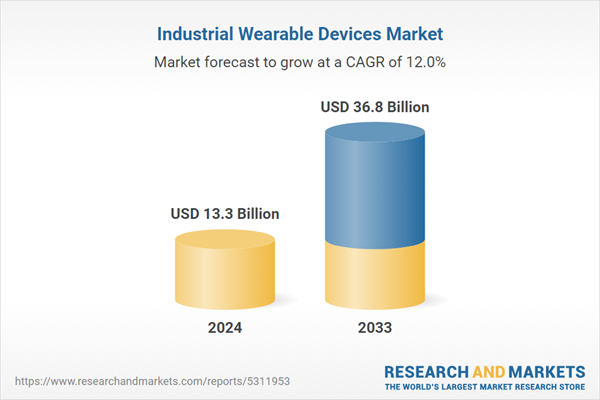Industrial wearable devices are functional tools designed to upgrade workplace productivity, safety and efficiency of the companies in sectors such manufacturing, logistics, healthcare, lifestyle, etc. These devices are made up of highly-sophisticated electronic components which collect data, track activities, and provide customized experiences depending on the users’ needs and desires. Moreover, they are geared to aid a worker to perform the assigned task at hand with greater ease and reduce accidents related to work.
Industrial wearable devices are rapidly gaining prevalence due to their numerous advantages, such as portability, convenience, operational efficiency, etc. In addition, improvement in bio-sensing technology in these devices helps in measuring health parameters such as body temperature, heart rate and blood oxygen levels. These parameters are further used by companies to track the employees’ health and are linked to their employee welfare programs, thereby reducing the healthcare costs. Further, industrial wearable devices can be used for real time data monitoring, workforce authentication, field management, corporate wellness and mobile workforce management. This is projected to increase their usage in different verticals, such as healthcare, IT & telecom, and manufacturing.
Key Market Segmentation:
The publisher provides an analysis of the key trends in each sub-segment of the global industrial wearable devices market report, along with forecasts at the global and regional level from 2025-2033. Our report has categorized the market based on product type, application and industry.Breakup by Product Type:
- Fitness Tracker
- Smart Glasses
- Smart Watches
- Wearable Camera
- Others
Breakup by Application:
- Warehouse Management
- Training & Simulation
- Service & Maintenance
- Others
Breakup by Industry:
- Transport & Logistics
- Retail
- Manufacturing
- Healthcare
- Others
Breakup by Region:
- North America
- Europe
- Asia Pacific
- Middle East and Africa
- Latin America
Competitive Landscape:
The competitive landscape of the market has also been examined with some of the top industrial wearable devices companies are being Apple, Epson, Fujitsu, Google, Microsoft, Vuzix, ASUS, Fitbit, Garmin, Honeywell, Jawbone, Motorola, Nike, Pebble, Samsung, SAP, Sony, Xiomi and Eurotech.This report provides a deep insight into the global industrial wearable devices market covering all its essential aspects. This ranges from macro overview of the market to micro details of the industry performance, recent trends, key market drivers and challenges, SWOT analysis, Porter’s five forces analysis, value chain analysis, etc. This report is a must-read for entrepreneurs, investors, researchers, consultants, business strategists, and all those who have any kind of stake or are planning to foray into the industrial wearable devices industry in any manner.
Key Questions Answered in This Report
1. What was the size of the global industrial wearable devices market in 2024?2. What is the expected growth rate of the global industrial wearable devices market during 2025-2033?
3. What has been the impact of COVID-19 on the global industrial wearable devices market?
4. What are the key factors driving the global industrial wearable devices market?
5. What is the breakup of the global industrial wearable devices market based on the product type?
6. What is the breakup of the global industrial wearable devices market based on the application?
7. What is the breakup of the global industrial wearable devices market based on the industry?
8. What are the key regions in the global industrial wearable devices market?
9. Who are the key players/companies in the global industrial wearable devices market?
Table of Contents
Companies Mentioned
- Apple
- Epson
- Fujitsu
- Microsoft
- Vuzix
- ASUS
- Fitbit
- Garmin
- Honeywell
- Jawbone
- Motorola
- Nike
- Pebble
- Samsung
- SAP
- Sony
- Xiomi and Eurotech
Table Information
| Report Attribute | Details |
|---|---|
| No. of Pages | 135 |
| Published | January 2025 |
| Forecast Period | 2024 - 2033 |
| Estimated Market Value ( USD | $ 13.3 Billion |
| Forecasted Market Value ( USD | $ 36.8 Billion |
| Compound Annual Growth Rate | 12.0% |
| Regions Covered | Global |
| No. of Companies Mentioned | 18 |









